With a host of changes to its engine, and a new chassis and new suspension, will the 2016 RM-Z250 be just what the doctor ordered for 250cc class success?
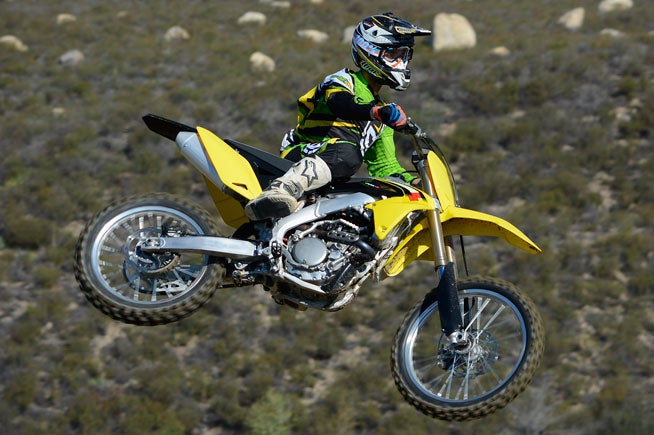
Suzuki performed so much surgery on the 2016 RM-Z250 that you would think it would look completely different than the 2015, but plastic surgery was obviously not on the chart; the RM-Z 250 looks virtually identical to last year’s model.
But that plastic is really more of a disguise, as the 2016 RM-Z250 is very different than its older sibling. Suzuki made more than 80 changes to the new RM-Z’s engine alone, and performance-wise it is supeior to the the 2015 model.The engine has been revised with the goal of delivering stronger low-end and mid-range power, and it boasts a more sophisticated fuel-injection and engine management system that incorporates a highly sophisticated launch control feature. The RM-Z’s chassis is also new, and its class-exclusive KYB suspension sports yet another variation of modern air fork design.
We’re glad Suzuki worked so hard to give the RM-Z250 a stronger heartbeat. It isn’t that the previous model was slow, but its 249cc, liquid-cooled, DOHC, four-valve, semi-dry-sump mill’s linear power was borderline anemic compared to some of its competition. A little preventive medicine comes in the form an engine that shares the 77.0mm bore and 53.6mm stroke of the 2015 model, but with parts updates intended to provide some more muscle. They include a new piston that has been shot-peened for better durability, and which features a new L-shaped top ring for better sealing. The wrist pin has been revised via the addition of a Diamond-Like Coating (DLC) to reduce internal friction and free up lost power. The RM-Z’s engine pulses are also meant to be a little stronger, as the RM-Z250’s compression ratio has been bumped from 13.5:1 to 13.75:1, although in a more holistic approach than the usual reshaping of the piston or the combustion chamber. Instead, new, flat-faced 31mm titanium intake valves replace the dish-shape valves used previously. The reduced chamber volume is from the valve faces is what increases the compression ratio. The flat-faced valves do weigh a little more, so lighter tappets are used to compensate. In an effort to widen the RM-Z250’s powerband, new camshafts that feature higher lift and greater duration are also employed, with the exhaust cam also receiving a lighter, simpler decompression mechanism that results in a negligible rotating mass reduction inside the engine – but hey, every little bit helps.
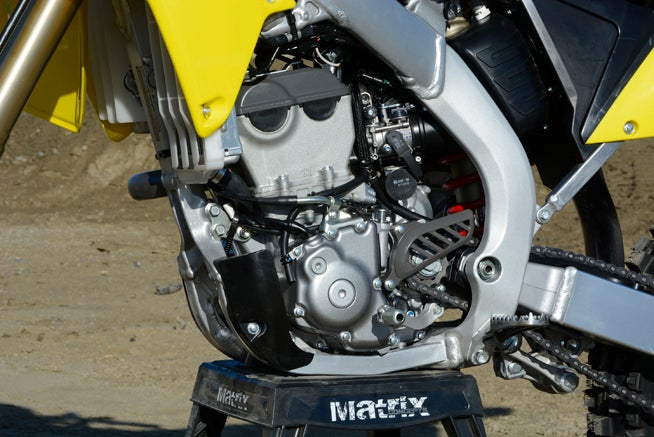
In addition to mass reduction inside the motor, Suzuki also focused on drag reduction, starting with the biggest hunk of metal in its bowels, the crankshaft. The 2016 crank is lighter thanks to a 0.5mm reduction in diameter, which reduces the amount of flywheel that spins through the engine oil in the RM-Z’s semi-dry sump cases. It’s a time-honored hot rod-style windage trick that reduces mechanical losses–since there is less crank going through the oil, there is less drag from the oil on the crank. The result is less mechanical power loss, which means more horsepower makes its way to the rear wheel. Of course, Suzuki then had to go and give some of that power back by incorporating a more massive ignition rotor that has 9% more inertia than the previous rotor to maintain the engine’s internal balance. The new rotor shifts the engine’s power delivery slightly lower in the rpm range. However, the RM-Z’s cases feature new internal machining that increases the clearance between the bottom of the flywheel and the floor of the crankcase, reducing drag while also increasing engine oil capacity from 1.05 to 1.1 quarts, which is A-okay because that extra oil is now managed better than before. Speaking of oil, the 2016 RM-Z also gets a new oil relief valve for better oil control and a redesigned clutch cover with a new window to permit quick inspection of the oil level.
Other attention to drag reduction was spent on the RM-Z’s cam chain tension system. The bladelike tensioners receive a slick Teflon coating to further reduce drag inside the engine. While making the change, Suzuki also opted to make the system more adjustable by increasing the number of stepped graduations available to dial-in the proper cam chain slack. Externally, the RM-Z250 also receives a new header pipe that has had its length increased 40mm to improve its mid-range power while also meeting the aforementioned AMA sound level requirements.
The RM-Z 250 was already a more consistent starter thanks to updates that were made over the past couple model years, but for 2016 Suzuki wanted the RM-Z250 to be easier to start as well as more consistent. To that end, there’s a revised kickstarter gear arrangement inside the engine. The primary kick ratio has been altered to increase leverage at the kickstart lever for easier starting. It seems to work, as firing up the RM-Z250 isn’t all that difficult.
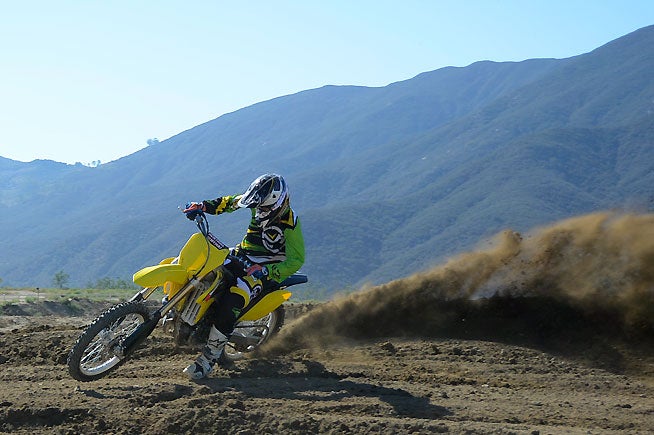
But Suzuki’s surgeons practiced a little more cutting-edge medicine: The 2016 RM-Z 250 receives a new Suzuki Holeshot Assist Control (S-HAC) that is more sophisticated than the one that appeared on the 2015 RM-Z450 (the 2016 450 gets the new one, too). The selectable launch mode system is designed to help riders get better starts in racing conditions. Like similar devices used by its rivals, the S-HAC is activated by a simple button on the handlebar, but the S-HAC differs from them in that it offers the rider a choice of three modes to match skill level and/or riding conditions. The first is the Base Mode, which simply means the unit is not activated. A Mode is for hard surfaces or slick conditions at the starting gate, such as with a concrete starting pad. To activate this mode, the rider holds down the S-HAC button for more than 0.7 second. B Mode is ideal for when traction is better and/or a more aggressive launch is needed, hold down the S-HAC button for more than 1.8 seconds.
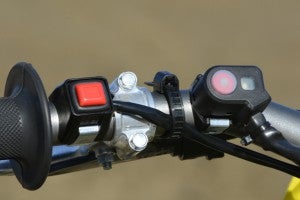 What makes the S-HAC interesting, at least on paper, is that it is a three-mode system, with the two active modes featuring three separate timing maps within each mode when in use. Unlike other systems where only one amount of timing retard is used for the entire launch sequence, the S-HAC offers three stages in A Mode or B Mode: 1) a specific amount of retard upon initial launch; 2) a specific amount of retard as the bike travels over the starting gate; and 3) a specific amount of retard past the starting gate as the bike begins to accelerate. However, Suzuki officials are very tight-lipped about the amount and the duration of ignition retard in each of the three stages. What we do know is that the system deactivates and full power is restored if the system’s gear position sensor recognizes that the transmission has been shifted into fourth gear, if the throttle position sensor recognizes that the throttle is closed, or if the ECM’s internal timer reaches six seconds after the initial launch.
What makes the S-HAC interesting, at least on paper, is that it is a three-mode system, with the two active modes featuring three separate timing maps within each mode when in use. Unlike other systems where only one amount of timing retard is used for the entire launch sequence, the S-HAC offers three stages in A Mode or B Mode: 1) a specific amount of retard upon initial launch; 2) a specific amount of retard as the bike travels over the starting gate; and 3) a specific amount of retard past the starting gate as the bike begins to accelerate. However, Suzuki officials are very tight-lipped about the amount and the duration of ignition retard in each of the three stages. What we do know is that the system deactivates and full power is restored if the system’s gear position sensor recognizes that the transmission has been shifted into fourth gear, if the throttle position sensor recognizes that the throttle is closed, or if the ECM’s internal timer reaches six seconds after the initial launch.
Suzuki also says that the S-HAC function is not affected by swapping to one of the alternative power mode couplers available to lean or richen the engine by 4%, and the entire system also provides a way for Suzuki mechanics to diagnose internal engine problems via a series of codes that are emitted from the LED when the proper diagnostic equipment is hooked to the motorcycle.
More surgery was performed on the RM-Z250’s 44mm Keihin throttle body, which has undergone a revision to reduce the engine braking effect during deceleration and when entering corners. To achieve this, Suzuki changed the angle of the throttle valve plate in the throttle body bore by a scant 0.5 degrees.
To demonstrate the new blood in the RM-Z250, Suzuki invited us to the ultra-fast, monster jump-filled Pala Raceway in Pala, California, just north of San Diego. Since this was the same location as our Honda CRF350R intro, our resident moto physical therapist, Ryan Abbatoye, was good and ready to exercise the RM-Z without having to learn a new track.
Right off the bat, we came to the realization that for all of its changes, there are a lot of words that could be used to describe the RM-Z250’s power delivery, but robust isn’t one of them. The RM-Z is still one smooth customer, with excellent throttle response and a rev happy personality. It produces decent bottom-end torque that transitions seamlessly into a slightly more authoritative mid-range, but that lunge tapers off as the engine reaches stratospheric rpm. Similar to its predecessor, the 2016 RM-Z’s engine isn’t slow, and we love that it revs so quickly, runs smoothly and is so linear, but it simply doesn’t feel like it is the fastest or most powerful engine in the class this year.
However, with its revised exhaust system, it may be the quietest, and we even wondered whether or not the lack of a sharp exhaust bark was affecting our judgment. It wasn’t. We attempted to boost the feel of the engine by opting for the leaner power coupler, which we snapped into place in less than a minute, and we found more happiness as we were able to coax a little more midrange out of the RM-Z with the swap. Although not as cool as the onboard power select mode adopted by at least one of its competitors, the Suzuki’s power couplers still offer a convenient way to alter the engine’s power character, so long as you aren’t an idiot and forget to throw them in your toolbox … And don’t ask us how we know that!
The secret to a fast lap time with the RM-Z250 is to keep the throttle pinned. It works best when the rider concentrates on conserving momentum. On the plus side, the RM-Z is less likely to sap a rider’s energy over the course of a long moto.
The key to quick lap times on the RM-Z250 lies in wringing its throttle to keep that rev-happy motor singing, using berms wherever possible to maintain momentum. Coming out of tight or slow corners, care must be taken to keep the RM-Z’s slick-shifting five-speed transmission in a lower gear and keep the revs high, which leaves less room for a lazy rider to rely on a snap of the clutch to pop the RM-Z over the next jump on the horizon. The closer it is, the more aggressive you need to be. That said, we do appreciate the throttle body plate change that Suzuki made. The 2016 model’s reduced engine braking allows the rider to roll a little deeper into a corner with less concentration, which helps to maintain momentum and makes it easier to string track sections together. As for our need for more thrust, Abbatoye recommended going up one tooth on the RM-Z’s rear sprocket, from 49T to 50T, to take better advantage of the engine’s available power. We intend to try that soon, and go with an aftermarket pipe, too.
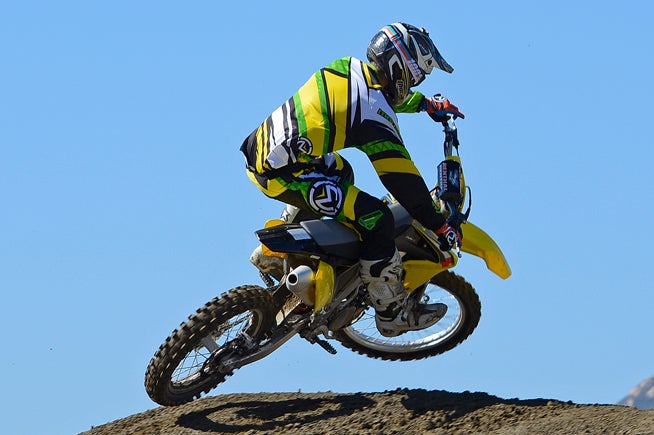
We did spend time experimenting with the S-HAC, and we find it to be a very useable addition to the RM-Z’s arsenal. We can say with 100-percent certainty that unless your racetrack’s starting gate is covered in ice, oil or rain-induced slime, you probably won’t need A-Mode, which seriously bogs the engine during first- or second-gear starts when there is even a hint of traction at the rear wheel. B-Mode, however? Now we’re talking! The S-HAC’s higher traction mode delivered easy and consistent second-gear starts every time for our Vet and Novice testers, although Experts can still dexterously tickle the clutch lever to get better starts with the system deactivated. It all depends on the surface, but we think Suzuki did a great job with its version of launch control.
The RM-Z250’s aluminum perimeter chassis leaves virtually no clue that it has been revised, as its 58.1-inch wheelbase and 29-degree rake and 5.1-inch trail numbers are identical to last year’s, yet the chassis upgrades for 2016 are substantial. For starters, its weight has been reduced by 2.5%, but its steering head pipe has been enlarged to mimic the size and design of the RM-Z450’s, which offers increased strength and durability, according to Suzuki. The frame’s side beams have new wider-spaced ribbing that is also claimed to increase strength while shedding weight. The forward down-tube and engine mount sections have been redesigned to for additional strength as well. Lastly, the RM-Z’s sub-frame has been revised and features new mounting points that prevent it from being interchangeable with the 2015 model.
The chassis is, to a certain degree, like the engine, in that the changes Suzuki made did little to alter how the RM-Z handles. This time, though it’s a really good thing, as RM-Zs have an excellent reputation for stability and turning prowess, and this one is no different. Abbatoye noted that the 2016 RM-Z250 delivers classic Suzuki handling. It corners well, and at 234 pounds (claimed, with its aluminum 1.7-gallon fuel tank filled to the brim), it is light and flickable on the ground or through the air.
“Suzukis are well known for cornering,” Abbatoye commented. “This one is stable, but it turns easily, and it goes wherever you want it to, whether you are chasing the berm or hugging the inside line, the Suzuki steers with precision, and it doesn’t matter whether the corners are rutted or smooth. It’s also really stable in heavy braking bumps, too. The front end tends not to dive, which can cause a nervous feel at the bars when you are on the brakes.”
And when it comes to suspension, well, time will tell, but the RM-Z250 certainly has to be considered a contender for best suspension in the 250cc motocross class – and maybe any class. Suzuki has done away with the coil-spring Showa SFF fork and brought the RM-Z250 into the air age with its new 48mm KYB PSF2 Pneumatic Spring Fork. As the name implies, the PSF2 has no coil springs, neither is it a separate function fork; the KYB features air chambers and damping cartridges in both fork legs, and it delivers 12.2-inches of front wheel travel. Out back, the RM-Z gets a new KYB shock that boasts all three damping adjusters positioned just above its piggyback reservoir for easier tuning. The fork and shock up the fine-tuning ante even further by offering, for the first time, high- and low-speed rebound as well as normal compression adjustment for the fork along with high- and low-speed compression and high- and low-speed rebound on the shock, which is naturally also preload adjustable via a threaded collar on the shock body.
Brand new KYB suspension components front and rear deliver impressive capability when it comes to soaking up monster landings on the RM-Z. With 12.2 inches of travel front and rear, it is also the most adjustable suspension currently on the market.
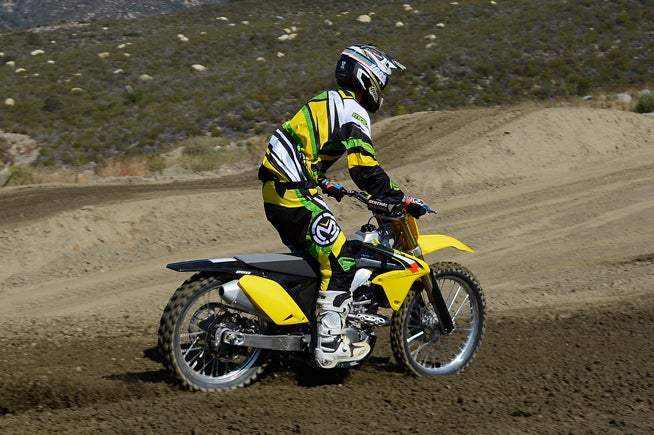
Unlike some 2016 machines we’ve sampled lately, the RM-Z’s suspension required little time to adjust to the point where we were happy with its performance. Credit to Suzuki for delivering a suspension package that soaked up any hit we encountered, big or small. The KYB components are truly remarkable. All we did was slow the PSF2 fork’s high-speed rebound down two clicks for a little better control of the suspension’s return stroke. That was it. We found no need to mess with the stock shock settings, which give the rear end’s 12.2 inches of wheel travel a plush yet controlled feel. The spring rates at both ends were well-suited to the fast Pala track, and the RM-Z250 tracked straight and true through rutted corners.
The RM-Z250’s braking performance is satisfactory as well. Its 250mm front and 240mm rear wave rotors, and two-piston front and single-piston rear calipers deliver smooth, powerful braking with a linear feel. They didn’t wow us in any way, nor did they raise any issues. We also like that the RM-Z250 comes standard with high-quality Excel rims and Dunlop’s awesome Geomax MX52 tires, which have proven themselves to deliver excellent traction and long wear life.
Despite the fact that it looks the same as it has for the past three years, the RM-Z250 also delivers a comfortable ergonomic layout with a flat seat and excellent bar-to-pegs relationship completing the triangle. As Abbatoye put it, the Suzuki is a bike you can get comfortable with instantly.
How well the Suzuki will do on the racetrack or the sales floor is yet to be seen, but the 2016 is definitely a better 250cc motocrosser than it was one year ago.
The 250cc motocross class is an unforgiving segment. Power, handling and suspension capable of tackling rough terrain are prescriptions for success. By our diagosis, Suzuki got two out of the three right for 2016. Frankly, we expected a lot more from its revised engine, and we are left to wonder whether the changes made to the RM-Z250 are enough. How well the Suzuki will do on the racetrack or the sales floor is yet to be seen, but the 2016 is definitely a better 250cc motocrosser than it was one year ago. If your local motorcross track is rough and twisty, the RM-Z250 may still be a healthy choice.
 2016 Suzuki RM-Z250 Specifications
2016 Suzuki RM-Z250 Specifications
MSRP: $7699
Engine: Four-stroke, liquid-cooled, DOHC, four-valve, single-cylinder
Displacement: 249cc
Bore x stroke: 77.0 mm x 53.6 mm
Compression ratio: 13.75:1
Starting system: Primary kick
Fuel system: Keihin fuel injection, 44mm throttle body
Injector type: single injector, 10-hole type
Ignition: Electronic (CDI) w/Suzuki Holeshot Assist Control
Exhaust system configuration/material: 1-into-1/stainless steel & aluminum
Clutch: Wet multi-plate type, rack & pinion actuation
Transmission: Five-speed
Primary drive gear ratio: 3.315 (63/19)
Final drive sprocket ratio: 3.769 (49/13)
Transmission gear ratio: 1st 2.153 (28/13)
2nd 1.764 (30/17)
3rd 1.470 (25/17)
4th 1.238 (26/21)
5th 1.090 (24/22)
Lubrication system type: Semi-dry sump
Oil capacity (oil and filter change): 1.0 quart
Fuel capacity: 1.7 gallons
Chassis: Twin spar aluminum perimeter frame, removable sub-frame
Front Suspension: 48mm KYB PSF-2 inverted telescopic fork, air spring, oil-damped, adjustable high- and low-speed compression and rebound damping, 12.2 inches of travel
Rear Suspension: Link type, KYB piggyback shock, adjustable high- and low-speed compression and rebound; preload adjustable, 12.2 inches of travel
Front Brake: 250mm wave-style disc, two-piston caliper
Rear Brake: 240mm wave-style disc, single-piston caliper
Front Wheel: 1.60 x 21-inch Excel aluminum rim w/stainless steel spokes
Rear Wheel: 1.85 x 19-inch Excel aluminum rim w/stainless steel spokes
Front Tire: 80/100-21-inch Dunlop MX52F
Rear Tire: 100/90-19-inch Dunlop MX52
Wheelbase: 58.1 inches
Rake/trail: 29° 20’/130 mm (5.1 inches)
Length: 85.4 inches
Width: 32.7 inches
Height: 50.0 inches
Ground clearance: 13.6 inches
Seat height: 37.6 inches
Claimed curb weight: 234 lbs.
Colors: Championship Yellow & Black:
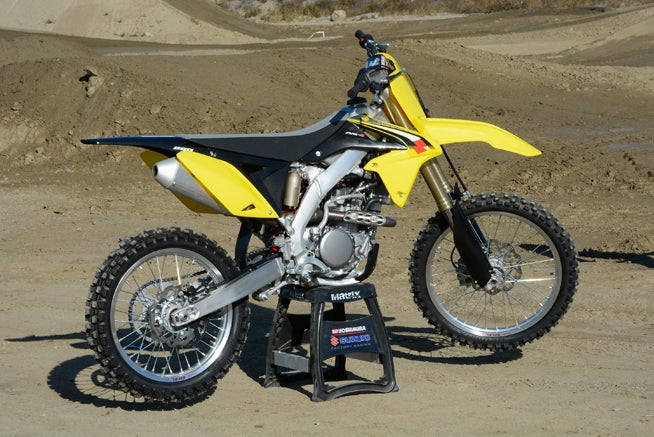
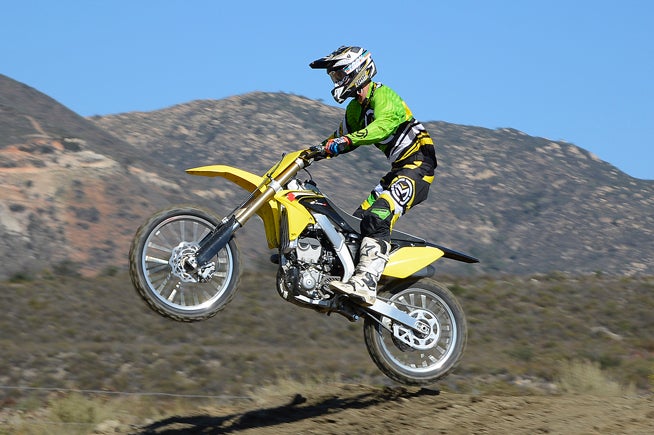
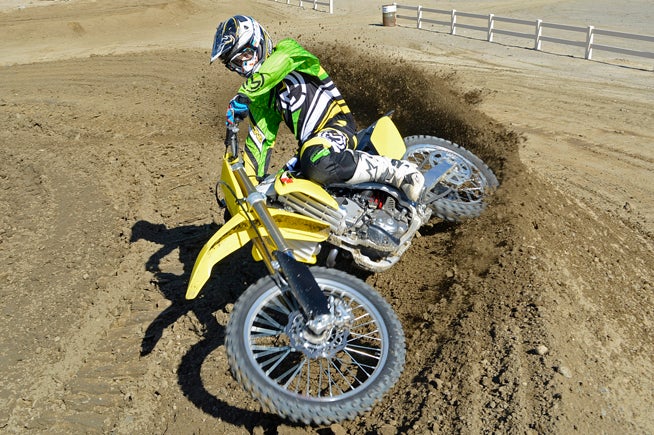
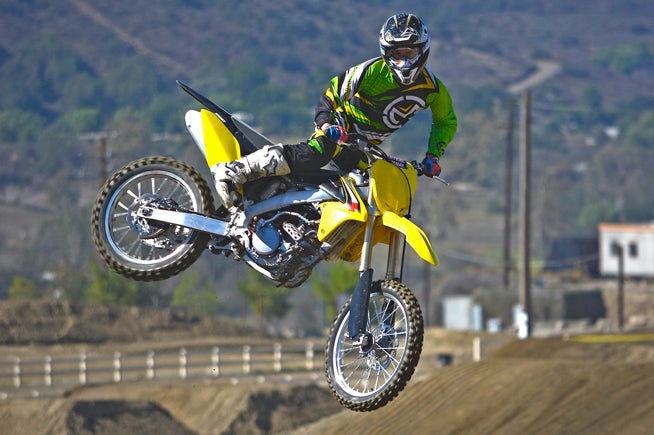
 Your Privacy Choices
Your Privacy Choices